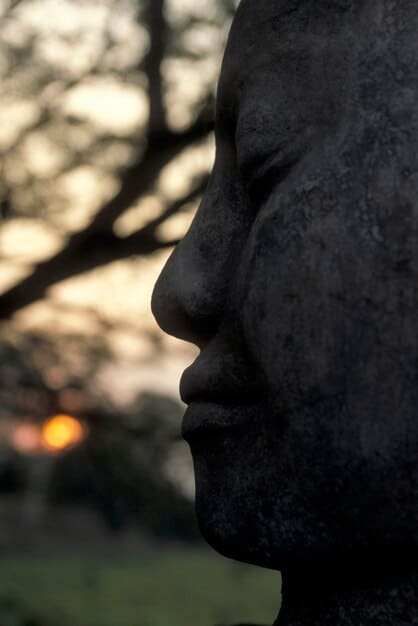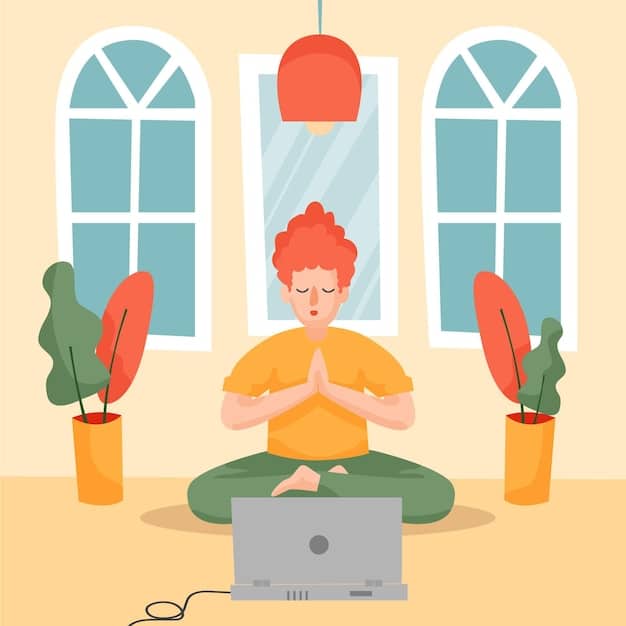Improve Focus: Samatha-Vipassana Meditation Guide

Samatha-Vipassana meditation offers a dual approach to cultivating mental clarity and insight, improving your focus and concentration through calming the mind and developing wisdom.
Do you struggle with maintaining focus and concentration in today’s fast-paced world? Improve your focus and concentration: a guide to Samatha-Vipassana meditation offers a path to enhanced mental clarity and inner peace. This ancient practice combines two powerful techniques to calm the mind and sharpen your ability to concentrate.
Understanding Samatha Meditation: The Path to Calm
Samatha meditation, often translated as “tranquility” or “calm abiding,” is a core element in many Buddhist traditions. It focuses on developing a calm, stable, and focused mind, laying the groundwork for deeper insights. It is vital for anyone planning to improve your focus and concentration: a guide to Samatha-Vipassana meditation.
The Core Principles of Samatha Meditation
Samatha meditation revolves around training the mind to rest on a single point of focus. This could be the breath, a visual object, or a mantra. The goal is to gently guide the mind back to the chosen object each time it wanders.
Benefits of Samatha Meditation
Regular practice of Samatha meditation offers numerous benefits, including reduced stress, improved sleep, and increased emotional regulation. It is your first step to improve your focus and concentration: a guide to Samatha-Vipassana meditation can set you upon.
- Reduces anxiety and stress levels
- Enhances concentration and focus
- Promotes relaxation and better sleep
- Develops emotional resilience
In essence, Samatha meditation is like tending to a garden: by weeding out distractions and cultivating a serene environment, you create fertile ground for deeper insight and well-being. It prepares the mind for the next, higher step in order to improve your focus and concentration: a guide to Samatha-Vipassana meditation.
Discovering Vipassana: Insight Through Mindfulness
Vipassana, which translates to “insight” or “clear seeing,” is a meditation technique aimed at developing a profound understanding of reality. It involves observing your thoughts, feelings, and sensations without judgment, gaining insight into their impermanent nature to improve your focus and concentration: a guide to Samatha-Vipassana meditation.

The Practice of Vipassana Meditation
Vipassana meditation encourages you to pay attention to your present experience, moment by moment. You become aware of the constant flow of thoughts, emotions, and sensations without getting carried away by them.
How Vipassana Differs from Samatha
While Samatha focuses on calming and concentrating the mind, Vipassana uses that calm to investigate the nature of reality. It’s a shift from focusing on a single point to observing the entire field of experience to improve your focus and concentration: a guide to Samatha-Vipassana meditation.
- Develops insight into the nature of reality
- Increases self-awareness and understanding
- Reduces reactivity to thoughts and emotions
- Promotes clarity and wisdom
Vipassana meditation cultivates mindfulness, helping you to see things as they truly are. It allows you to break free from habitual patterns of thinking and reacting, leading to greater freedom and peace of mind, especially as you seek to improve your focus and concentration: a guide to Samatha-Vipassana meditation.
The Synergy of Samatha-Vipassana: A Unified Path
The real power of these techniques lies in their combination. Samatha provides the calm and stable foundation necessary for Vipassana’s insightful inquiry. Together, they create a powerful synergy for enhancing focus, concentration, and overall well-being as you improve your focus and concentration: a guide to Samatha-Vipassana meditation.
Building a Strong Foundation
Starting with Samatha allows you to tame the restless mind, making it easier to observe your thoughts and emotions without getting swept away. This foundation is essential for effective Vipassana practice.
Moving from Calm to Insight
Once you have developed a degree of calm and focus through Samatha, you can then gently introduce Vipassana techniques. This involves shifting your attention from the object of focus to the ever-changing flow of your experience. The guide to improve your focus and concentration: a guide to Samatha-Vipassana meditation can set you upon this specific path.
Samatha-Vipassana meditation is like building a house: Samatha is the foundation, providing stability and strength, while Vipassana is the structure, allowing for exploration and understanding. They complement each other, leading to a balanced and holistic practice.
Practical Tips for Starting Your Practice
Embarking on a Samatha-Vipassana meditation journey can seem daunting at first, but with the right guidance and a bit of patience, anyone can benefit from this powerful practice. This advice will help you improve your focus and concentration: a guide to Samatha-Vipassana meditation.
Creating a Conducive Environment
Find a quiet and comfortable space where you can sit undisturbed. Minimize distractions such as noise, bright lights, or electronic devices. A dedicated meditation space can significantly enhance your practice.
Setting Realistic Expectations
Don’t expect immediate results. Cultivating calm and insight takes time and consistent effort. Start with short sessions and gradually increase the duration as you become more comfortable.
Starting your Samatha-Vipassana meditation practice is like learning a new skill: it requires patience, perseverance, and a willingness to learn. Embrace the process, and you will gradually experience the profound benefits of this transformative practice.

Overcoming Common Challenges
Like any new skill, meditation can present challenges. It’s common to experience a wandering mind, physical discomfort, or even boredom. Understanding these obstacles and developing strategies to overcome them is key to a successful and helpful approach to improve your focus and concentration: a guide to Samatha-Vipassana meditation.
Dealing with a Wandering Mind
The mind naturally wanders. When you notice your attention drifting, gently guide it back to your chosen object of focus without judgment. Each time you do this, you are strengthening your ability to concentrate.
Managing Physical Discomfort
Find a meditation posture that is comfortable for you. This might involve sitting on a cushion, chair, or even lying down. Adjust your position as needed to minimize discomfort.
- Acknowledge the distraction without judgment.
- Gently redirect your attention back to your breath or object of focus.
- Experiment with different meditation postures to find what works best for you.
- Be patient and kind to yourself throughout the process.
The challenges encountered in meditation are opportunities to develop resilience, self-awareness, and compassion. By learning to navigate these obstacles, you not only deepen your practice but also cultivate valuable life skills to improve your focus and concentration: a guide to Samatha-Vipassana meditation.
Deepening Your Practice: Resources and Guidance
As you progress in your Samatha-Vipassana meditation journey, it can be helpful to explore additional resources and seek guidance from experienced teachers. This will help you improve your focus and concentration: a guide to Samatha-Vipassana meditation.
Books and Online Resources
There are countless books and websites offering guidance on Samatha-Vipassana meditation. Some reputable sources include works by renowned meditation teachers such as Joseph Goldstein, Sharon Salzberg, and Jack Kornfield.
Finding a Teacher or Group
Connecting with a qualified meditation teacher or joining a meditation group can provide invaluable support and encouragement. A teacher can offer personalized guidance, while a group can foster a sense of community and shared learning.
Deepening your Samatha-Vipassana practice is like embarking on an adventure: it requires exploration, curiosity, and a willingness to learn from others. Embrace the journey, and you will continue to discover new depths of insight and well-being and improve your focus and concentration: a guide to Samatha-Vipassana meditation.
| Key Point | Brief Description |
|---|---|
| 🧘 Samatha | Calming the mind through focused concentration. |
| 🧠 Vipassana | Developing insight by observing thoughts and sensations. |
| ✨ Synergy | Combining Samatha and Vipassana for balanced practice. |
| 🧘🏽♀️ Practice | Consistent meditation improves focus and clarity. |
Frequently Asked Questions
▼
Samatha focuses on calming the mind and improving concentration, while Vipassana uses that calm to gain insight into the nature of reality through mindful observation.
▼
Consistency is key. Aim for daily practice, even if it’s just for 10-15 minutes. Gradually increase the duration as you become more comfortable with the techniques.
▼
It’s normal for the mind to wander. Gently redirect your attention back to your breath or object of focus without judgment. This process strengthens your concentration.
▼
Yes, you can practice them separately, but their combined practice offers a more balanced and holistic approach to meditation, enhancing both calm and insight.
▼
For most people, meditation is safe. However, if you have a history of mental health issues, it’s best to consult with a healthcare professional before starting a practice.
Conclusion
Samatha-Vipassana meditation offers a powerful and effective way to enhance focus, concentration, and overall well-being. By combining the calming effects of Samatha with the insightful inquiry of Vipassana, you can cultivate a balanced and transformative practice. Begin integrating these techniques into your daily life and experience the profound benefits of a clear and focused mind.





